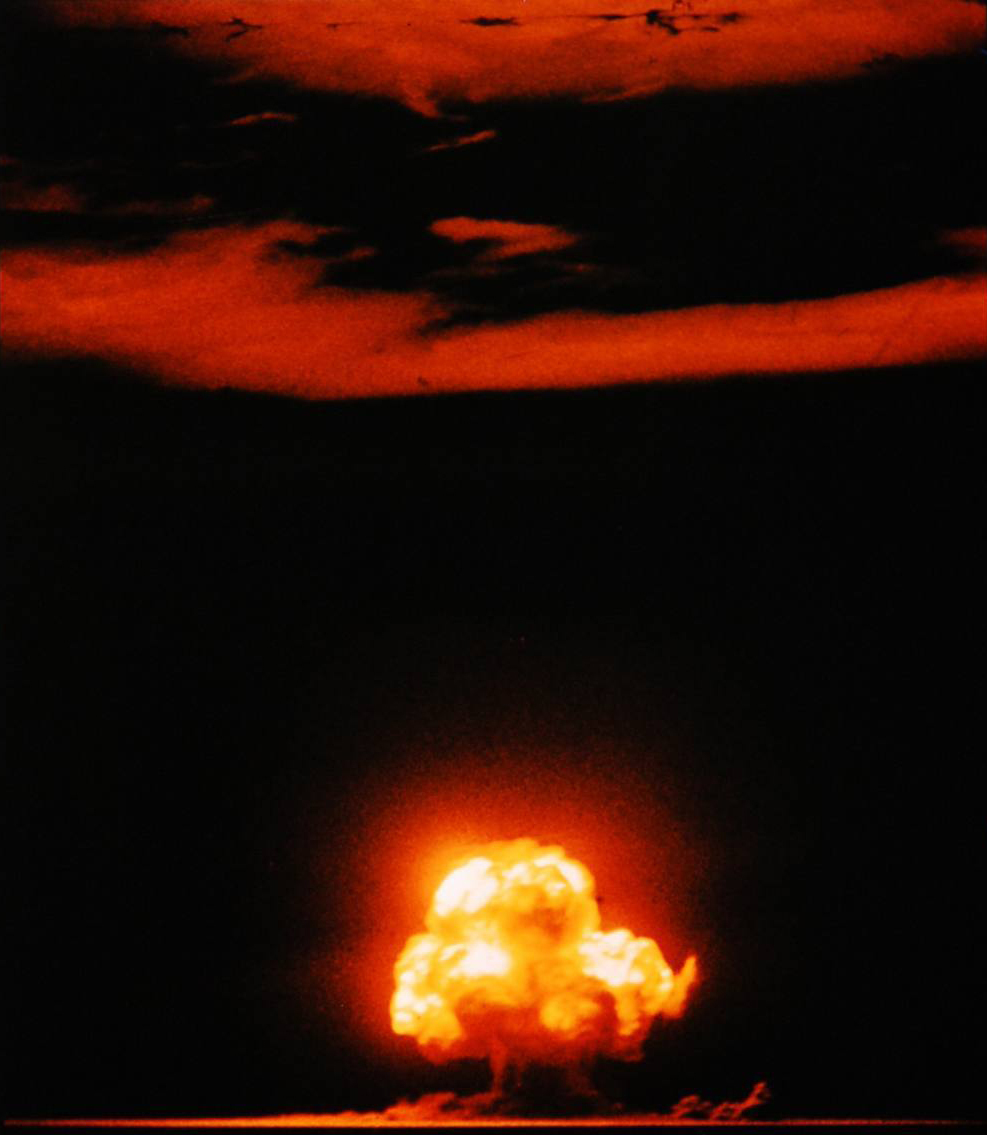
Original colour-exposed photograph taken on July 16, 1945, by Jack W. Aeby, an environmental physicist working under the aegis of the Manhattan Project. Source: Wikipedia
The Dawn of Destruction
In the remote desert of New Mexico, some of the world’s most talented scientists and engineers secretly worked for three years on a project that, if successful, would change the world’s history. On the pre-dawn morning of July 16, 1945, these scientists, engineers, and military personnel gathered in tense anticipation, as the top-secret Manhattan Project reached its zenith.
At 5.29 a.m., near Alamogordo, the detonation of the plutonium-based implosion bomb produced a blinding flash of light and a thunderous roar, heralding the dawn of the atomic age. This historic scientific achievement, known as the Trinity Test, transformed global geopolitics and brought about a new era of unparalleled power and profound ethical dilemmas, particularly for some participants.
We all know what happened next. In August 1945, the United States dropped atomic bombs on the Japanese cities of Hiroshima and Nagasaki. The immense devastation and loss of life caused by these bombs were unprecedented, leading to Japan's surrender and the end of World War II in the Pacific.
But let’s go back to the day of the Trinity Test. When the bomb exploded with a force equivalent to 20 kilotons of TNT, a massive mushroom cloud rose into the sky, dispersing radioactive particles over a vast area. Despite the significant health risks, the government did not inform the residents - mostly Hispanic and Native Americans -before the test or afterwards to take protective actions, and no evacuations were conducted.
Several ranchers reported that fallout resembling flour was visible for 4 or 5 days after the blast. The radioactive dust contaminated the environment, infiltrated homes, coated crops and permeated water sources. Residents as close as 19 km from ground zero collected rainwater from metal roofs for drinking.
The First Victims of the Atomic Bomb were American Children
After the Trinity test, residents experienced acute radiation sickness symptoms, such as nausea, hair loss, and skin burns. Local doctors across New Mexico began to notice worrying trends in infant mortality rates. In October 1947, Dr. Kathryn S. Behnke, a healthcare provider from Roswell, New Mexico, wrote to Stafford Warren, a radiologist and safety chief of the Trinity operation, that infant deaths were rising in the months after the test: “As I recall, in August 1945, the month after the first bomb was tested in New Mexico, there were about 35 infant deaths here.”
Warren’s assistant responded to the letter by assuring Behnke that there was no link between infant mortality and fallout. He emphasized that “the safety and health of the people at large is not in any way endangered.” Over time, more insidious effects, including cancer, thyroid disorders, and genetic mutations, began to manifest. More than 70 years later, documents revealed that the infant death rate in New Mexico was 56% percent higher in 1945 compared to previous years.
Seventy-nine years have passed since the Trinity test in New Mexico. To most Americans, nuclear testing and radiation belong to the Cold War history. For downwinders - a term that refers to the residents and communities that were most impacted by the nuclear tests and radioactive fallout - the devastating effects of testing are felt daily in their communities. They are still fighting for recognition.
Every thinking person fears nuclear war, and every technological state plans for it. Everyone knows that it is madness, and yet every nation has an excuse to produce and possess atomic weapons. It's a deadly chain of causality. The Germans were working on the bomb at the beginning of World War II, so the Americans had to make one first. Albert Einstein and Leo Szilard, a Hungarian-American physicist who played a pivotal role in the development of the atomic bomb highlighted this threat in a letter to President Franklin D. Roosevelt, urging the United States to accelerate its own efforts. The fear that Nazi Germany might develop nuclear weapons first, had been a significant force for many scientists to work on the Manhattan Project.
Nuclear Winter
Entering the Cold War era, with Americans having the nuclear bomb, the Soviets had to have one as well, and then the British, the French, the Chinese, the Indians, the Pakistanis, and the Israelis (though this has not been publicly confirmed) and North Korea. There are more than 12,000 nuclear warheads worldwide, with the United States and Russia accounting for over 90% of them. No place on the planet is safe. The destruction from the detonation of the world’s nuclear arsenal would be catastrophic, and the long-term effects such as nuclear winter and radioactive fallout, could potentially make the planet uninhabitable for much of human and animal life.
The term ‘nuclear winter" was coined by American atmospheric scientist Richard P. Turco in the early 1980s. In December 1983, he co-authored the groundbreaking study "Nuclear Winter: Global Consequences of Multiple Nuclear Explosions" with Owen Toon, Thomas P. Ackerman, James B. Pollack, Carl Sagan, and Paul J. Crutzen, published in the journal Science. Using climate models, they predicted the long-lasting global climatic effects caused by the smoke and soot produced by widespread fires ignited by nuclear explosions. They argued that the detonation of nuclear warheads during the thermonuclear war might produce enough dust and debris to prevent a sufficient amount of sunlight from entering the atmosphere, thus inducing a perpetual winter or nuclear winter.
Carl Sagan was instrumental in bringing the concept of nuclear winter to the public's attention. His unmatched ability to engage the public with science has made him a cultural phenomenon. Recognising the mounting threat of a nuclear arms race, he became increasingly political; he wrote articles, gave lectures and appeared on television programs to explain the science behind nuclear winter and its implications for humanity. By illustrating the horrific consequences of nuclear war, he made a compelling case for reducing nuclear arsenals and preventing the spread of nuclear weapons.
Carl Sagan — "The World After Nuclear War" (1984)
Current geopolitical tensions have renewed fears of nuclear conflict. Meanwhile, advances in missile technology, cyber warfare, and the modernisation of nuclear arsenals add new layers of complexity to the threat of nuclear war. Sagan's predictions about nuclear winter remain a stark reminder of the ultimate consequences of these advancements if they lead to conflict.
The real utility of nuclear weapons is in their ability to provoke fear. Their existence is immoral. Organisations like the International Campaign to Abolish Nuclear Weapons (ICAN) work tirelessly towards banning nuclear weapons. No matter what obstacles we face, we must continue pushing for the complete abolition of nuclear weapons.
What if We Nuke a City? Source: Why a ban? - ICAN
Published on The Climate Historian
Sources and Further Reading:
Carl Sagan — "The World After Nuclear War" (1984) (youtube.com)
Doomsday Clock - Bulletin of the Atomic Scientists (thebulletin.org)
https://www.un.org/en/observances/end-nuclear-tests-day/history
R.P.Turco, O.B. Toon, T.P. Ackerman, J.B. Pollack and Carl Sagan, “Nuclear Winter: Global Consequences of Multiple Nuclear Explosions,” Science 222, no 4630 (1983):1283-1292
